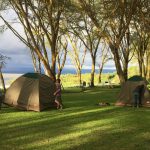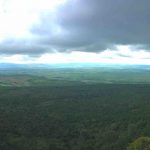Post by Peiwen Li and Karen Ong
After breakfast, we loaded the gargantuan bus and headed off for Lake Naivasha, leaving at 9 am. We shared bittersweet goodbyes to the new friends we made at Angiri Camp, including Peter, Maurice, and Susan. We’ll miss them dearly – Maurice even fried up some chicken samosas and vegetarian chapati for our last meal. We travelled to Lake Naivasha via Nairobi and along the way, we encountered a flooded underpass. Cautiously, we proceeded and continued along winding roads to see the Rift Valley escarpment.
Initially when we disembarked from the bus, the sun was shining bright giving us a clear view of vast forests beneath us. We saw three tree hyraxes foraging in the branches of trees beneath the retaining wall. Hyraxes (Order: Hyracoidea) are among the closest extant relatives of the elephants and sea cows. These little critters resemble small groundhogs in size but sport a dark cinnamon pelt. Colouring depends on geographic location, ranging from light grey to dark brown. Amongst the lush green valleys, a man-made concrete road stood out, disrupting the harmonies view below. On our way back to the bus, we stopped by a small souvenir shop. One of the workers there informed us that all the stores in this area provide support to the local orphanage located deep in the valley. These orphans actually made some of the jewellery that is sold in the store. We picked up a few more gifts and continued on our way.
Just a few minutes after we left, the skies opened and rain started pouring. A thick fog set over the Rift Valley casting an ominous pall over the truck. The roads quickly flooded but the locals appeared unalarmed and carried on with their days.
We arrived at Camp Carnelley’s at 5pm, right at the shore of Lake Naivasha. Njoro and Chenzen demonstrated how to set up the tents then we each claimed our spots and set up our tent homes for the next 5 days. After setting up, we spread out and explored the campsite. We stumbled upon an African fish eagle perched at the top of a dead tree, surveying the surface of the lake for prey (we presume). It had a gleaming white head, neck and breast. The beak was bright yellow and black. The body was a pure black except for a reddish-brown shoulder stripe. We learned that females are larger than males, which commonly occurs in raptors.
Wenxi hand-caught a Mascarene rocket frog (Ptychadena mascareniensis) near the lake. It had a greenish-brown back and a broad yellow dorsal line with 8 dorsal folds. Currently, it is their breeding season and males will produce duck-like calls to attract mates. Wenxi was actually trying to identify another frog but was distracted by this beautiful frog chorus.
Distributed throughout campsite, fever trees (Acacia xanthophloea) towered, providing us and the vervet monkeys a dense canopy from the hot sun. Vervet monkeys have a sandy-brown coat and black face. When in heat, the testicles turn a bright blue to attract a female.
As the sky darkened, the hippos began foraging along the shoreline. With our headlamps on, we rushed to the edge of the electric fence and watched two hippos eating grass. They shuffled back to the lake shortly after we arrived. Their slow steps don’t reveal their immense burst speeds, able to attain burst velocities of >30 km/hr.
After dinner, Nestor and Zoey presented their article reviews. Nestor’s paper studied mammalian hotspots and Zoey discussed how habitat fragmentation poses an especially high threat to forest understory bird species. This wrapped up our day perfectly and we can’t wait to see the dawn on Lake Naivasha!
Click on thumbs to see larger versions.
- African fish eagle at Lake Naivasha
- Tree hyrax at stop by edge of rift valley
- Egyptian gees pair with goslings
- Members of the Lougheed lab at the Rift Valley rim
- Chenzen getting a better view
- Chloe looking a bit worried about traffic
- Chenzen and Njoro demonstrating how to set up a tent
- Davin and Joaquin setting up their tent
- Setting up camp
- Panorama of Rift Valley










Leave a Reply